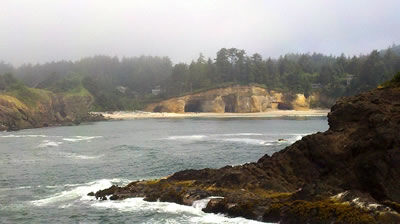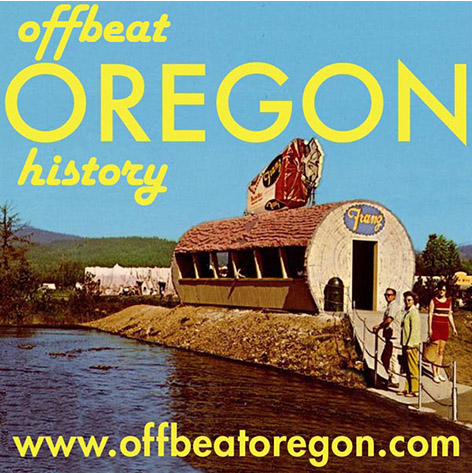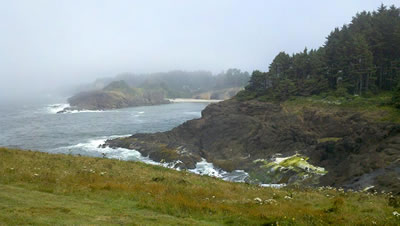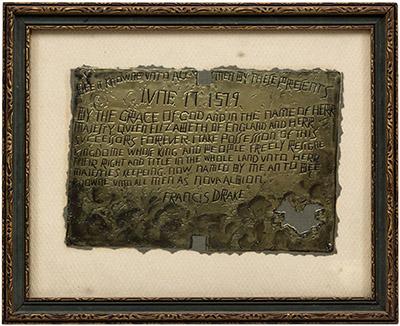WHALE COVE, LINCOLN COUNTY; 16th CENTURY:
Did Sir Francis Drake visit Oregon in 1579?
Audio version: Download MP3 or use controls below:
|

Upon his return to Britain, Ward says, Drake and Queen Elizabeth conspired to fake up the record so that Spanish spies wouldn’t find out how close he’d been to finding a Northwest passage. This, Ward suggests, is why some documents say the bay was at 38 degrees latitude, and others say it’s at 44. Drake had planned to return later and explore the passage; but political developments with the Spanish forced him to stay close to home, and he never made it back. Ward has spent 30 years and a significant amount of his own money trying to confirm this theory. There have been archaeological digs, ground-penetrating radar, and bay dives. Nothing has been found, other than an old English coin found decades ago in the possession of a native. It should be pointed out that Whale Cove is a notoriously treacherous place to navigate — as at least one crew of rumrunners learned, to their dismay and to the locals’ delight, during Prohibition, when an attempted booze delivery went on the rocks and left the beach strewn with bottles of Scotch. It’s also in a very dangerous part of the coast. For Ward’s theory to be correct, Drake would have had to sail directly past a number of great natural harbors — Willapa Bay, Tillamook Bay, Nestucca Bay, and Depoe Bay, just to name a few — and chosen as his sanctuary one of the least navigable spots on the coast. (Of course, fog may have played a role in cloaking those alternatives from view.) Moreover, Ward is not the only one working on an alternative Nova Albion theory. Nehalem resident Gerry Gitzen has built an impressively voluminous, if circumstantial, case for Nova Albion being Nehalem Bay, a little farther north. He’s even found some artifacts — carven stone survey markers — that might be old enough to be evidence of Drake’s presence. And a Canadian, R. Samuel Bawlf, has advanced a theory that Nova Albion was actually Vancouver Island, and that the cove Drake dropped anchor in was Comox Bay. The proponents of the California site, naturally, are feeling a little hard-pressed by all this. “He’s working on a fantasy,” scoffed a former president of the Drake Navigators Guild in California, when he heard of Ward’s theory. More recently, the Navigators Guild lent its support to an application to have Drake’s Bay designated as a national landmark. When this was approved, in 2012, Edward von der Porten, the current president of the Guild, said it was tantamount to official recognition of the Drake’s Bay theory. “We’re very pleased the National Park Service has chosen to say yes,” he told reporter Guy Kovner of the Santa Rosa Press Democrat. “Were there any scholarly debate, this would not have happened.” That’s not what the Parks Department said, though. In an e-mail to Kovner for the same story, Park Service spokesman Mike Litterst noted that the nomination form for the site didn’t even mention the controversy over where Drake landed, and added, “(This) should not be interpreted as providing a definitive resolution of the discussion.” Probably the best one-line summary of the question of where Nova Albion really was came from archaeologist Melissa Darby, in an interview with Colin Fogarty of National Public Radio. Darby, at the time, was studying the Whale Cove site. “Darby says that as a scientist, she doesn't trust anyone who's 100 percent sure of something that happened more than four centuries ago,” Fogarty reported.
|
Background photo is an image of Highway 395 on the shores of Abert Lake, made by F.J.D. John in 2016.
Scroll sideways to move the article aside for a better view.
Looking for more?
On our Sortable Master Directory you can search by keywords, locations, or historical timeframes. Hover your mouse over the headlines to read the first few paragraphs (or a summary of the story) in a pop-up box.
... or ...

©2008-2017 by Finn J.D. John. Copyright assertion does not apply to assets that are in the public domain or are used by permission.



